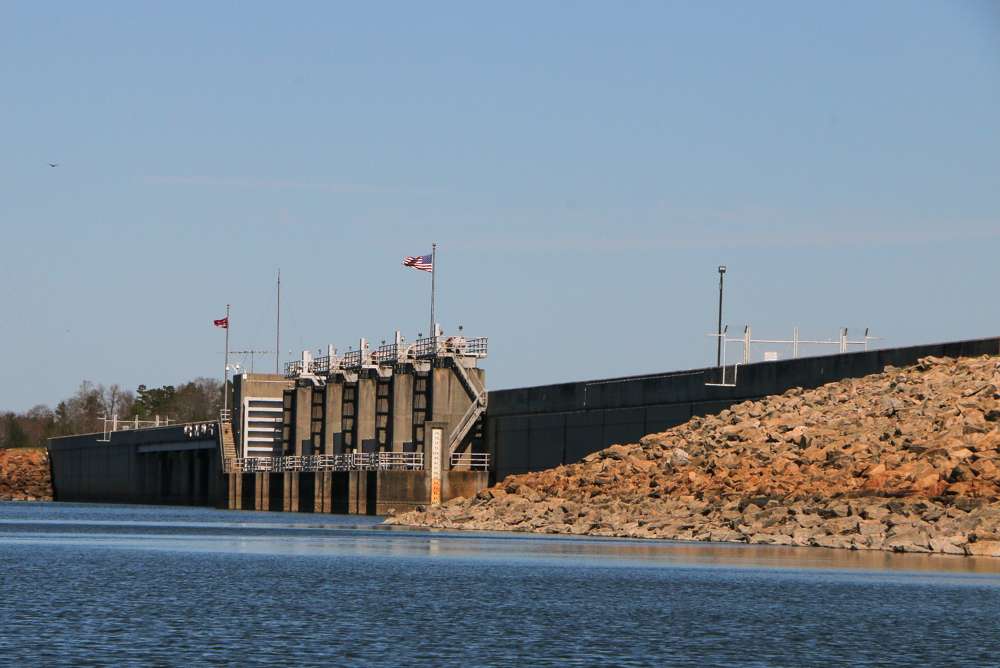
Call it a change of occupancy. Gone are the textile mills, the horse-drawn carts packed with market goods and all the ambient glow of a once-bustling town known as Andersonville. In its place, a healthy population of largemouth and spotted bass that’ll challenge and reward the field of 52 who’ll soon seek to unlock Lake Hartwell’s secrets during the GEICO Bassmaster Classic presented by DICK’S Sporting Goods.
Settled around 1800, Andersonville was named after Revolutionary War veteran Robert Anderson and once boasted the reputation of a well-known port and resort town that included a barge system with daily routes to Savannah. By the time construction on the Hartwell Dam began in 1955, the town had already dwindled considerably, due in large part to its being bypassed by the railroads.
Four years after the dam’s completion in 1959, the Hartwell impoundment flooded Andersonville’s remnants. Today, only the time-beaten roads and crumbling ruins of the 400-acre Andersonville Island (near Portman Marina, buoys LBC1 – LBC9 and S1 – S13) hint of a town’s existence. Infinitely more prominent, of course, is that famous lake maker, so let’s check out the key details.
The dam
Authorized by the Flood Control Act of 1950 and built by the U.S. Army Corps of Engineers, this 12,400-foot hydroelectric dam stands seven miles below the point at which the Tugaloo and Seneca rivers unite to form the Savannah River.

With an estimated cost of $68.4 million (based on 1948 price levels and preliminary designs), the original project comprised a 2,415-foot gravity-type concrete dam with earth embankments of 6,050 feet on the Georgia side and 3,935 feet on the South Carolina side. The complete dam was topped with a 24-foot-wide roadway.
The main dam consists of two non-overflow concrete sections on the right and left banks 887 feet and 940 feet long, respectively; a gravity-type concrete spillway 588 feet long equipped with 12 tainter gates (radial arm flood gates) 26 feet by 40 feet in the channel; and a powerhouse on the South Carolina side.
The reservoir
Covering 56,000 surface acres with 962 miles of shoreline and an average depth of 45 feet (maximum 185), Lake Hartwell straddles the Georgia-South Carolina border and was created for a full power pool of 660 feet above mean sea level. At normal pool, the lake extends 49 miles up the Tugaloo and 45 miles up the Seneca.
Hartwell’s impoundment required significant adjustments to existing infrastructure. Three railroad sections totaling 2 miles had to be moved, two railroad bridges and four highway bridges needed raising, six sections of new state highway (19.6 miles), nine sections of county roads (12.7 miles) and nine new bridges had to be built and two power transmission lines had to be relocated.
Historically, the average lake elevation is 657.5 feet, but Hartwell reached it’s highest level, 665.4 feet on April 8, 1964. On the other extreme, following severe drought in the southeastern U.S., Hartwell fell more than 22 feet below normal pool in December 2008. Exposing old highways, sunken boats and other normally covered features, the lake reached its lowest level, 637.49 feet, on Dec. 9.
The transplants
Now, getting back to those Hartwell bass, Dan Rankin, regional fisheries coordinator for South Carolina’s Region 1 (Piedmont Mountain area), points out that the spots arrived via unauthorized introductions. Rankin said studies have shown no significant impacts on largemouth bass stocks and, much to anglers’ delight, the spots seem to be ever increasing in quality and quantity.
One likely factor in health of spotted bass (and largemouth) numbers are the lake’s blueback herring. As Rankin explains, bluebacks were inadvertently collected during South Carolina’s effort to stock threadfin shad throughout the Savannah River reservoirs. Threadfins were netted in the Santee-Cooper lakes and the small number of bluebacks that made it into Hartwell have proven pleasantly prolific.
“I don’t think anyone expected that an anadromous species would live in a landlocked reservoir but the bluebacks have flourished,” Rankin said. “During extreme winters, we typically have a threadfin shad die-off, but bluebacks are more cold tolerant, so they can survive in lower temperatures. The threadfin always rebound, but the bluebacks carry the forage base until their numbers rebuild.”
Notably, the Hartwell forage base is rich with options. Joining threadfin shad and bluebacks are gizzard shad, various sunfish and another anadromous species, the hickory shad. The latter also was an unauthorized introduction.
Historical notes
Referencing the “History of the Savannah District, 1829 – 1989,” written by Henry E. Barber and Allen R. Gann and published by the U.S. Army Corps of Engineers, Savannah District in 1989, LakeHartwellLiving.com tells us that the lake was named for Nancy Hart, Georgia’s most famous female Revolutionary War participant. Also the namesake of Georgia’s Hart County and the city of Hartwell, this feisty patriot/spy was renowned for her fierce determination to rid the Upcountry of Tories, English soldiers and British sympathizers.
Another notable figure in Hartwell’s history was a Cherokee Indian maiden named Issaqueena, who famously rode to Fort 96 to warn settlers of an attack. During her journey, she recorded her route by naming streams according to the number of miles she had traveled. Issaqueena’s naming of Six-Mile, Twelve-Mile, Three-and-Twenty Mile and Six-and-Twenty Mile creeks created geographic references still used today.
Like most engineering achievements, it’s hard to look at a sturdy, functioning Hartwell Dam and Reservoir and see anything but success. However, there were times in the project’s history when the wheels of progress ground to a halt.
Notwithstanding the usual bumps and stumbles, two significant delays threatened the project’s future. First was a dispute with a private land owner who wasn’t keen on the government acquiring her land (eventually settled), while another saw Clemson University vigorously press concerns over the damage an impoundment would do to its property. Ultimately, the impasse was bridged with an agreement that included two diversion dams to rechannel the Seneca River.
Despite these significant challenges, the Hartwell Dam and Reservoir Project succeeded in creating one of the most famous and recreationally treasured lakes in the Eastern U.S. A true gem with rich historical relevance, Lake Hartwell offers an ideal venue for some fortunate angler to write their own chapter in history by lifting the 48th Bassmaster Classic trophy.

